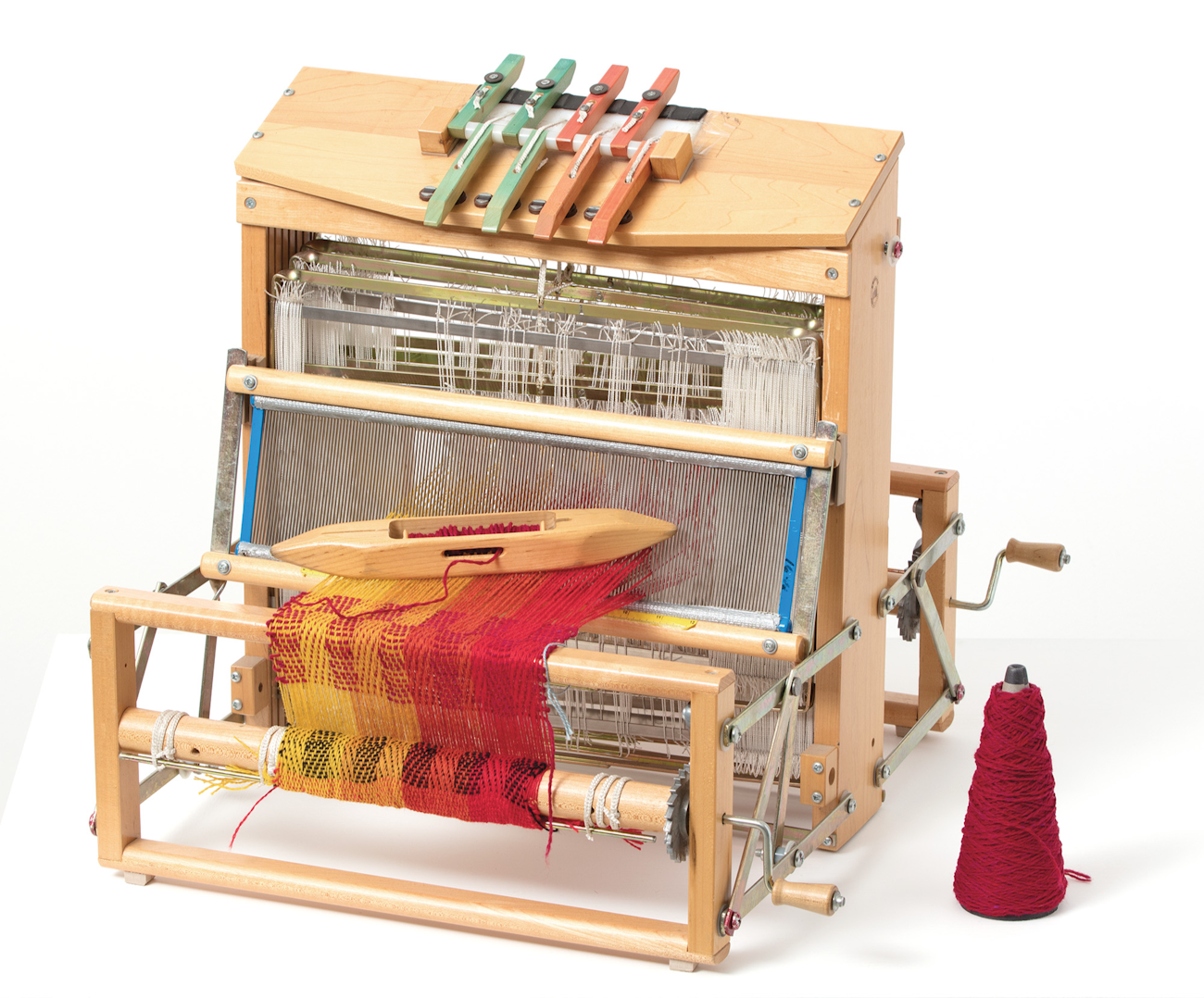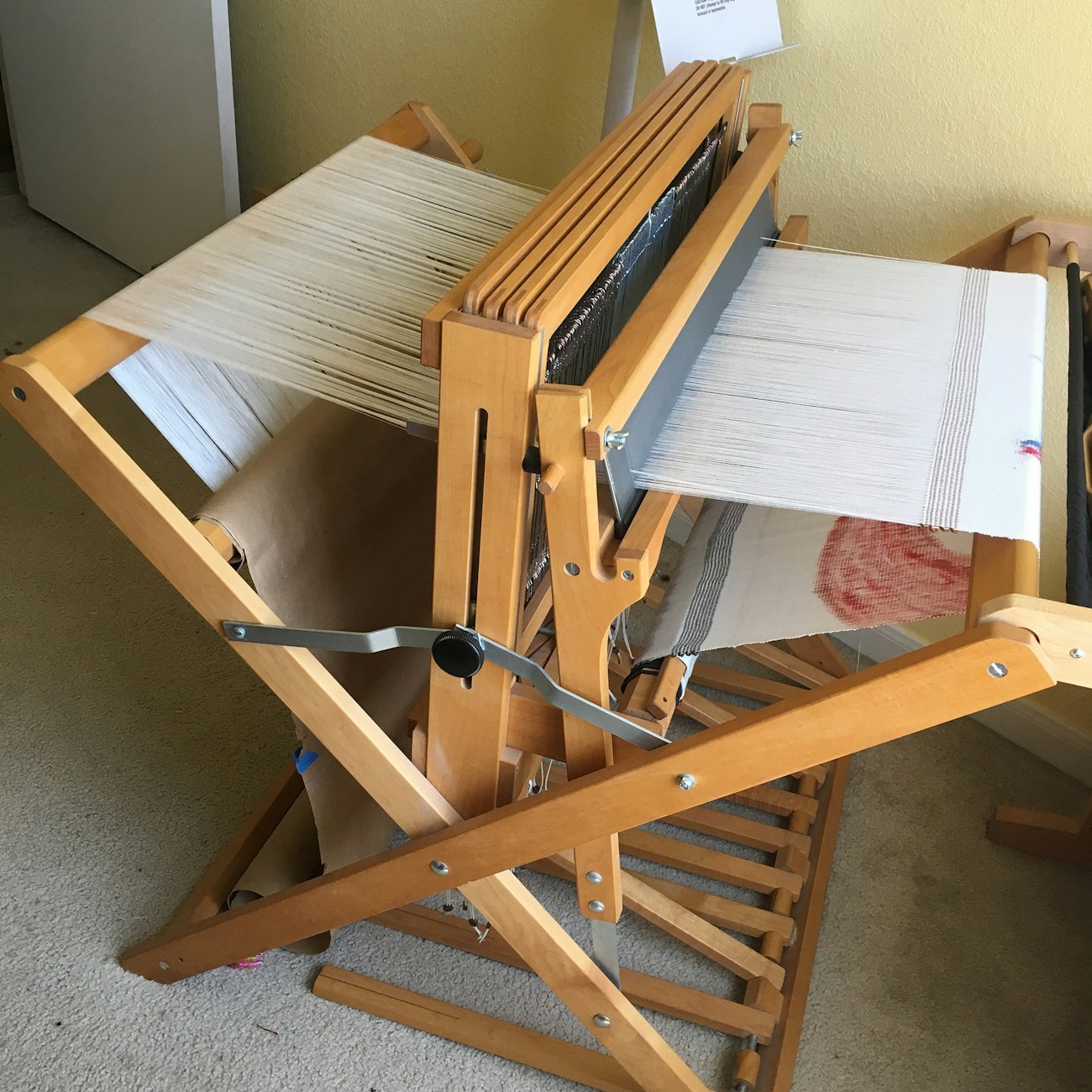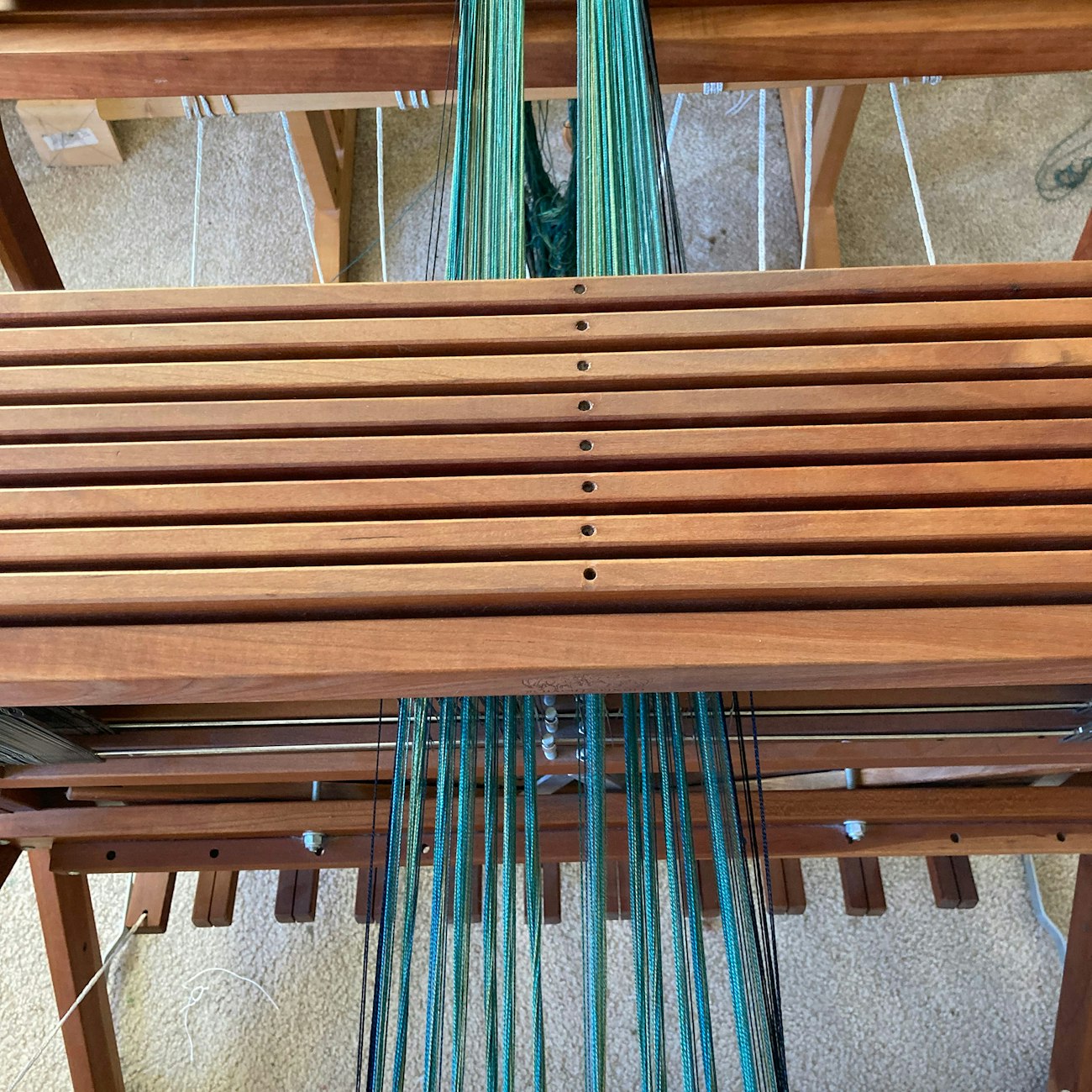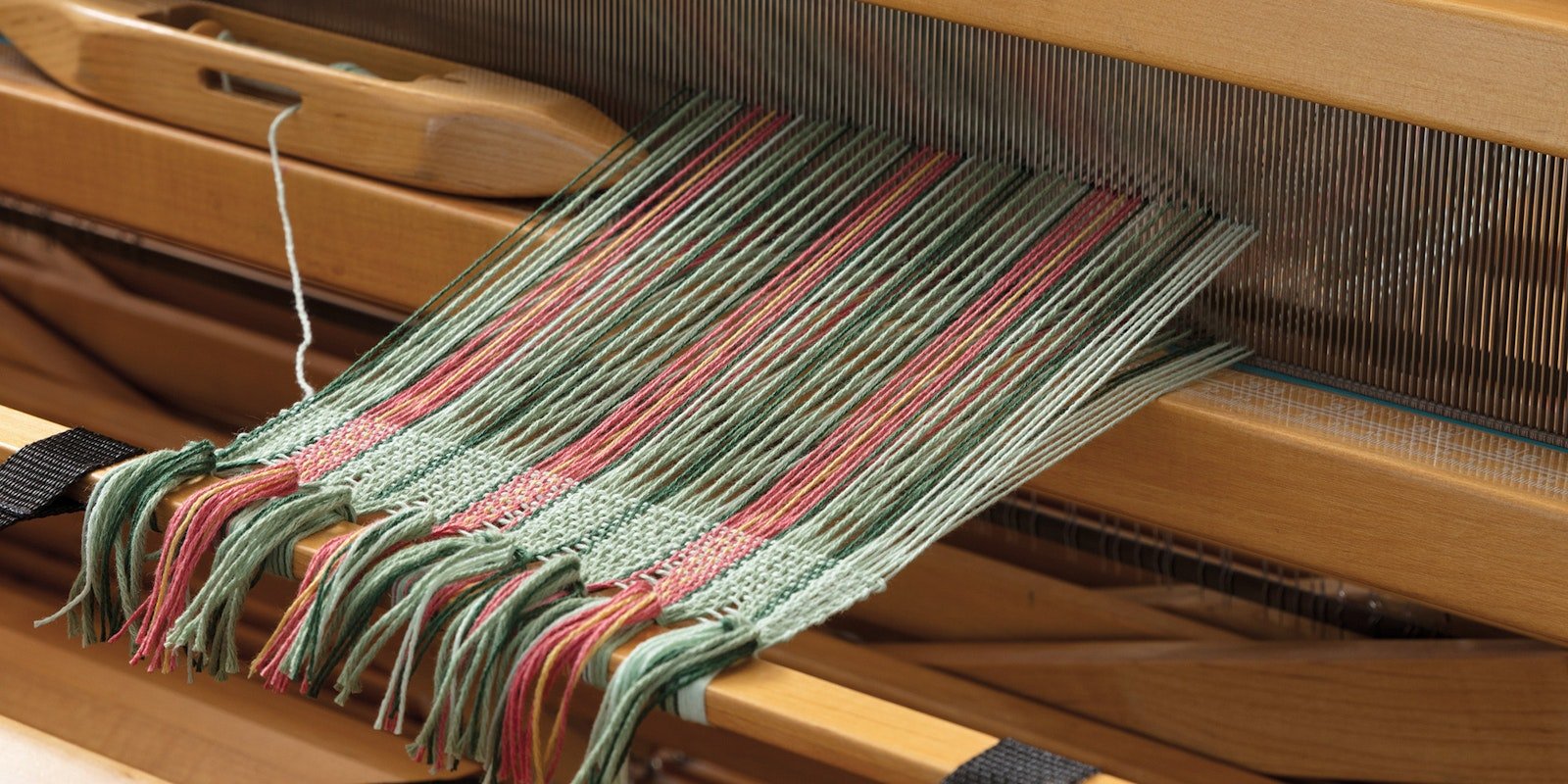Want to buy a loom but not sure how to pick what’s best for you? Deb Essen provides some tips that will help you narrow the field. —Christina
I’m often asked, “What’s the best loom to buy?” My answer is always, “It depends.” I know this answer makes everyone crazy, but choosing the best loom for you depends on many factors. Before you go loom shopping, here are some questions to consider.
 Table looms, true to their name, fit easily on a table. They tend to be narrower than other multishaft looms, so they’re good for weavers who have limited space or who want to take a loom on the road. Weavers who have limited mobility in their knees, hips, or legs may prefer to use the levers on table looms rather than the treadles on floor looms.
Table looms, true to their name, fit easily on a table. They tend to be narrower than other multishaft looms, so they’re good for weavers who have limited space or who want to take a loom on the road. Weavers who have limited mobility in their knees, hips, or legs may prefer to use the levers on table looms rather than the treadles on floor looms.
1. What’s your budget?
Looms are available in a wide range of prices and sizes. If you’re planning to buy a new loom, you can learn about what’s available and the pricing range at loom manufacturer or retailer websites. Knowing your general budget should help you narrow those options down.
When you set your budget, don‘t forget to include the cost of multiple reeds. Owning both 8-dent and 10-dent reeds will handle 90 percent of weaving projects, but if you love fine yarns, it’s nice to also have a 12-dent reed. If you are a color/texture weaver, you‘ll want a 5- or 6-dent reed to accommodate chunky, textured yarns. Reeds can be interchanged on looms of similar size. I have 8-, 10-, and 12-dent reeds that work on both of my floor looms. Stainless steel reeds are more expensive, but they won’t rust like their carbon steel counterparts can in humid environments.
If a new loom is out of your budget, consider previously loved looms. Often used looms come with bonus yarns, tools, reeds, and maybe even a bench! One warning: Beware of buying a used loom without inspecting it in person. It’s just too easy to overlook missing parts (brake cranks are important) or broken parts (such as cracked beater supports) when you buy based only on photos. To make sure everything is weaving-ready, walk through the warping steps when you inspect the loom.
2. What do you plan to weave?
Weavers tend to fall into two categories: technical weavers who love to play with weave structures, and color/texture weavers who love to play with color and different yarns. As Madelyn van der Hoogt says, “Color/texture weavers collect yarn. Technical weavers collect yarn and looms.”
Personally, I’m a technical weaver. I own two floor looms (a big four-shaft jack loom and a twelve-shaft countermarch with drawloom attachment) and two rigid-heddle looms. I’d like an eight-shaft loom, but I don’t have studio space. I’m trying to convince my husband that the weaving studio should swap space with our large family room—but that’s another story.
The type of projects on your weaving list may also affect the type of loom that will work well for you. A heavier loom can weave a delicate scarf and still handle the heavy beat needed for a rag rug. Lighter, smaller looms weave wonderful textiles but can’t handle the firm beat required for a good rug.
3. How much room do you have?
Do you have a large studio—or will you need to move the loom out of the way when you host guests? A big countermarch can’t be folded up or easily moved, so if space is tight, an X-frame jack loom that can be folded may better serve you. My jack loom is 60 inches wide and almost as deep when open, but only 24 inches deep when folded. Weight is another consideration: It takes two people to safely fold and unfold my heavy loom. It looked so much smaller in the weaver’s guild loom room when I bought it!
 This Schacht Baby Wolf loom with an x-frame folds up neatly to allow Katrina’s studio to serve as a guest room for her dad’s visits. Photo by Katrina King
This Schacht Baby Wolf loom with an x-frame folds up neatly to allow Katrina’s studio to serve as a guest room for her dad’s visits. Photo by Katrina King
4. How long are your legs and arms?
I‘m 5 feet 4 inches tall, and my maximum shuttle-throwing warp width is 40 inches. If you plan to weave very wide pieces, you may need a wider loom equipped with a fly-shuttle system. (Doubleweave is another solution for weaving wider pieces, but it won’t work for heavy rugs.)
If you have long legs, they may not fit comfortably under some looms. If you are short, make sure you can sit at the front beam with your elbows bent at 90 degrees. If not, you‘ll need a taller bench—but then you should make sure your feet can still reach the treadles.
5. Do you want to explore weave structures?
You can weave happily for years on a four-shaft loom, but the moment you decide to explore turned twill or weave summer and winter with more than two blocks, suddenly you‘ll realize you don’t have enough shafts! The one recommendation I make to weavers looking for their first loom is to buy eight shafts so they have room to grow in their weaving.
 Katrina’s first loom has eight shafts, which provides her the flexibility she needs to explore pattern in her weaving. Photo by Katrina King
Katrina’s first loom has eight shafts, which provides her the flexibility she needs to explore pattern in her weaving. Photo by Katrina King
6. Do you need the loom to be portable?
If you move house often or want to take the loom to workshops, a small, easily portable table or floor loom would be a wonderful choice.
If you plan to travel with a loom, is it foldable? Even better, can it be folded while warped? Make sure it will fit in your car or suitcase. And check the weight—can you manage it on your own, or will you need a helping hand?
7. How are your knees and back?
Seriously, this is an issue. It takes substantially more leg strength to raise multiple shafts of a wide warp under tension on a jack loom than it does on a countermarch. And you won‘t enjoy weaving if your knees are hurting.
If you have a bad back, can you easily get under the loom to tie up the treadles and comfortably reach the heddles for threading? If the loom has an overhead beater (common with countermarch or counterbalance looms), can you remove it by yourself if you warp back to front?
Next steps
Once you’ve asked yourself these questions, you will have a better idea about what kind of loom will make you happy. Then it’s time to test-drive! Take a class in which you can check out several looms. Visit your local weaving shop. Go to fiber festivals and weaving conferences where the loom manufacturers have booths. Visit fellow guild members and try out their looms. Ask questions!
Every weaver has a favorite loom—and usually it’s the one they own. Keeping these questions in mind, ask them why they like their loom. In the end, remember that looms of all sizes and shapes are good, but the perfect loom is the loom that fits your needs, interests, budget, space, and life.
Deb Essen weaves, teaches, and creates kits for handweavers for her business, dje handwovens, in the beautiful Rocky Mountains of Montana.
Originally published September 20, 2018; updated July 17, 2024.

